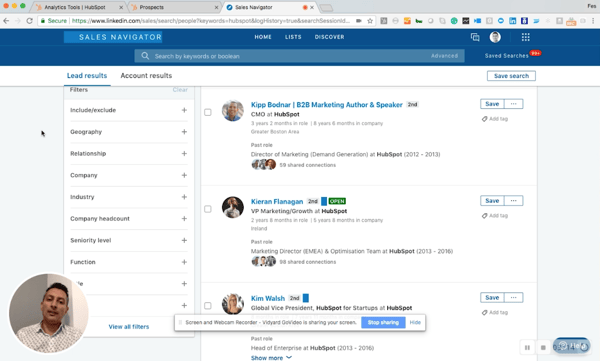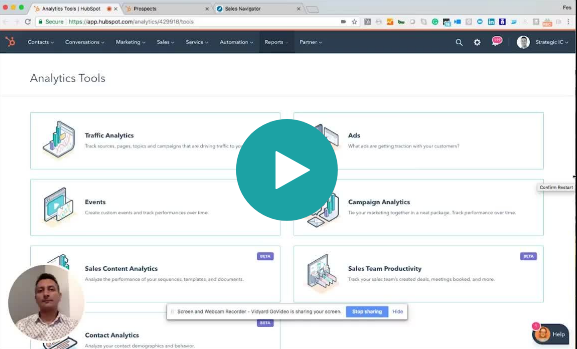Head of Inbound Sales, Fes, provides insight and tips, as well as a short video walkthrough of how to generate early-stage sales conversations using HubSpot and Sales Navigator.
You can also view the video in full screen here.
How To Generate Early-Stage Sales Conversations

Video Transcript
In the run up to our September breakfast event, we're going to be doing some actionable tips videos for B2B sales and marketing teams. We're running a breakfast session in London on the 19th of September; this event is going to be hosted by ourselves and HubSpot, and in it we'll be talking about the themes of sales and marketing alignment, but also helping B2B marketing and sales teams generate more early-stage sales conversations.
Note: this September 2018 event has now passed, however the tips included in this article remain relevant.
This is going to be quite a quick video, so I'm not going to go through all of the details on this dashboard here, but this is the HubSpot analytics tool suite.

HubSpot have been doing some great work on their UX so you can see here, it's a really easy to use, easy to navigate dashboard for sales and marketing teams.
What, I'm actually going to look at in the bottom right-hand corner of this section of the platform, is the prospects tool. Now prospects is almost like a level up from Google Analytics. You apply the HubSpot tracking code to your website, and then HubSpot starts to identify the accounts and businesses visiting your site.

So this is an example of the HubSpot prospects report from our own agency website data. It's historical data from a year ago or so. If I was developing this type of report for your sales and marketing team, it would be for within the last two or three weeks. So what we're trying to do here is not just identify the accounts, but also add some filtering criteria because we only really want to look at good-fit accounts, and that may be based on your ICP or buyer persona.
So this list has been filtered by a time period, but also accounts over $100,000,000. Now, HubSpot aren't a target account for us, they are a partner. But if they were a target account, we could see that HubSpot has been engaging with our content at quite a high level over this period; 17 page views within a couple of months. So what I would look to do is build a list based on a target account profile with increasing levels of engagement. Now I'm going to do a separate video about intent data and analytics (at a later date), but this is a very basic version of B2B intent data. What we can do here, is identify the accounts that are visiting the website and also the location of those accounts. In this case it's the US. So what we're trying to do here is build a list of relevant target accounts, before using a tool like Sales Navigator to identify relevant contacts within that account - again, based on your ICP or buyer persona.

What we're looking for is a contact; in our case that will be senior sales and marketing decision makers within an account like HubSpot. So one key principle of this is to remember that prospects may not be accounts that have converted into your database yet. They may be accounts that are demonstrating some early-stage interest in your solutions area. So you've got to be careful about the messaging that you promote into the account at this stage. They're not sales ready yet, or perhaps they're not. So when you approach the account contact, you need to create a messaging and content strategy that may align to their buyer stage, which may be an early-stage research and evaluation process that they're going through. But if you can get into the account with the right message at this stage, it may allow you to help influence their decision-making process at the early stages.
So for example, if you created a target account list and then a contact list for the sales team using Sales Navigator, we could also provide the sales team with the messaging strategy that may go something like this:
"Hi Kipp, I understand that some of the team at HubSpot have been researching Inbound and Account-Based Marketing on our agency website. I'd love to share a copy of our recent Inbound Marketing Executive Briefing as I think this may help address some of the challenges you have as an Enterprise technology vendor."
So it's a very light touch, buyer-centric message. It's not really promoting a sales message at this stage. What you could then do, is expand that messaging into other contacts within the account, based on your profile of a decision-making unit for a target account.
This tactic is essentially allowing marketing teams to drive more value through the website traffic that they're generating. You might be spending thousands or tens of thousands of pounds generating site visits. However you may only be sharing the leads that have converted on your forms or your chat with the sales team. Here, this may be an opportunity for you to generate some additional early-stage sales conversations by giving the sales team a list of the accounts and contacts that may be demonstrating some early buyer intent.
I hope this has been helpful - if you have any questions about this process or activity, feel free to get in touch and perhaps I can share some more insights.
Video transcribed by Temi




